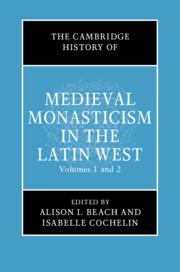Book contents
- The Cambridge History of Medieval Monasticism in the Latin WEST
- The New Cambridge History of Medieval Monasticism in the Latin West
- The Cambridge History of Medieval Monasticism in the Latin WEST
- Copyright page
- Contents
- Figures
- Contributors
- Acknowledgments
- Abbreviations
- 1 General Introduction
- Part I The Origins of Christian Monasticism to the Eighth Century
- 2 The Monastic Laboratory: Perspectives of Research in Late Antique and Early Medieval Monasticism
- 3 Re-Reading Monastic Traditions: Monks and Nuns, East and West, from the Origins to c. 750
- 4 The Archaeology of the Earliest Monasteries
- 5 Egyptian Nuns in Late Antiquity as Exemplars
- 6 Psalmody and Prayer in Early Monasticism
- 7 Heterodoxy and Monasticism around the Mediterranean Sea
- 8 The Invention of Western Monastic Literature: Texts and Communities
- 9 Monastic Rules (Fourth to Ninth Century)
- 10 Social Plurality and Monastic Diversity in Late Antique Hispania (Sixth to Eighth Century)
- 11 Female House Ascetics from the Fourth to the Twelfth Century
- 12 The Archaeology of the Earliest Monasteries in Italy and France (Second Half of the Fourth Century to the Eighth Century)
- 13 Nuns and Monks at Work: Equality or Distinction between the Sexes? A Study of Frankish Monasteries from the Sixth to the Tenth Century
- 14 Ascetic Prayer for the Dead in the Early Medieval West
- 15 Monastic Identity in Early Medieval Ireland
- 16 Constructing Monastic Space in the Early and Central Medieval West (Fifth to Twelfth Century)
- 17 The Economy of Byzantine Monasteries
- Part II The Carolingians to the Eleventh Century
- Part III The Long Twelfth Century
- Part IV Forms of Monasticism in the Late Middle Ages
- Index
- References
9 - Monastic Rules (Fourth to Ninth Century)
from Part I - The Origins of Christian Monasticism to the Eighth Century
Published online by Cambridge University Press: 16 January 2020
- The Cambridge History of Medieval Monasticism in the Latin WEST
- The New Cambridge History of Medieval Monasticism in the Latin West
- The Cambridge History of Medieval Monasticism in the Latin WEST
- Copyright page
- Contents
- Figures
- Contributors
- Acknowledgments
- Abbreviations
- 1 General Introduction
- Part I The Origins of Christian Monasticism to the Eighth Century
- 2 The Monastic Laboratory: Perspectives of Research in Late Antique and Early Medieval Monasticism
- 3 Re-Reading Monastic Traditions: Monks and Nuns, East and West, from the Origins to c. 750
- 4 The Archaeology of the Earliest Monasteries
- 5 Egyptian Nuns in Late Antiquity as Exemplars
- 6 Psalmody and Prayer in Early Monasticism
- 7 Heterodoxy and Monasticism around the Mediterranean Sea
- 8 The Invention of Western Monastic Literature: Texts and Communities
- 9 Monastic Rules (Fourth to Ninth Century)
- 10 Social Plurality and Monastic Diversity in Late Antique Hispania (Sixth to Eighth Century)
- 11 Female House Ascetics from the Fourth to the Twelfth Century
- 12 The Archaeology of the Earliest Monasteries in Italy and France (Second Half of the Fourth Century to the Eighth Century)
- 13 Nuns and Monks at Work: Equality or Distinction between the Sexes? A Study of Frankish Monasteries from the Sixth to the Tenth Century
- 14 Ascetic Prayer for the Dead in the Early Medieval West
- 15 Monastic Identity in Early Medieval Ireland
- 16 Constructing Monastic Space in the Early and Central Medieval West (Fifth to Twelfth Century)
- 17 The Economy of Byzantine Monasteries
- Part II The Carolingians to the Eleventh Century
- Part III The Long Twelfth Century
- Part IV Forms of Monasticism in the Late Middle Ages
- Index
- References
Summary
In a study of late antique and early medieval monastic rules in the West, one logical starting point is Benedict of Aniane’s early ninth-century Codex regularum. We depend to an enormous degree on the sources that he has provided for us. The Codex (in the Munich manuscript, Bayerische Staatsbibliothek, Clm 28118) is by far the most extensive early medieval collection of monastic rules: twenty-four rules for monks and six rules for nuns. Many of them would probably have been lost if Benedict of Aniane had not collected and preserved them. He also produced a second work, the Concordia regularum, in which he arranged most of the material of his collection so that it corresponded thematically, chapter by chapter, with what we now think of as the Rule of St. Benedict (RB, and what he thought of as the work of the sixth-century Benedict of Nursia).
- Type
- Chapter
- Information
- The Cambridge History of Medieval Monasticism in the Latin West , pp. 162 - 194Publisher: Cambridge University PressPrint publication year: 2020
References
Monastic Rules
Bibliography
- 1
- Cited by

